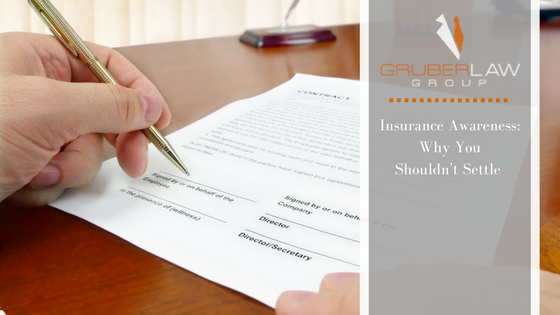 Navigating insurance law and the claims process after an accident is extremely complicated, and insurers know that injury victims usually feel out of their depth. They often take advantage of this fact by making the process seem even more daunting but then offering you an “escape hatch” settlement. Their hope is that you feel relieved to receive any money at all.
Navigating insurance law and the claims process after an accident is extremely complicated, and insurers know that injury victims usually feel out of their depth. They often take advantage of this fact by making the process seem even more daunting but then offering you an “escape hatch” settlement. Their hope is that you feel relieved to receive any money at all.
The people who need their personal injury compensation most badly often do feel relief, and they unfortunately say “yes” to a settlement that offers them pennies on the dollar. Instead, injury victims should be arguing their claim to the best of their ability and forcing the insurer to get as close to the full amount they deserve as possible.
To help you accomplish this goal, you can learn a little bit more about the typical claims process and how a personal injury lawyer in San Francisco helps navigate it.
Claims Process Step 1: A Demand Letter Is Sent
When you are filing a claim on someone else’s liability insurance, you are effectively making demands for payment. This demand should include the full amount of damages, the legal justification in brief for filing the demand — e.g. a property owner was negligent — and all the available evidence the filing party has to back up their claim.
Not realizing how extensive their initial demand should be, many people file based on only their most immediate medical costs, and they may fail to provide the full extent of documentation needed to justify their claim. So, in other words, they are asking for less money than they deserve and providing scant evidence to compel the insurer to give it to them. As a result, they end up at step two:
Step 2: A “Lowball” Personal Injury Compensation Offer Is Sent
Even when working with a lawyer, most injury victims will receive a response from insurers that attempts to poke holes in their case along with an offer far lower than the total amount they are entitled to. Their hope is to put the claimant on the defensive, make them feel like they have few options, and then make them feel grateful that they are getting any money at all.
Realize that you do not have to say “yes” to this initial offer. You can assert your right to full compensation and also back up your claim by presenting the full facts and restating your most compelling points.
For instance, if the insurer tries to say “you have a back injury, but it won’t result in permanent pain, so you don’t need $X” you can point to x-rays, medical documentation and statistics to indicate that people with injuries similar to yours often have extensive long-term care and medication costs.
Step 3: The Insurer and Injury Victim Negotiate Back and Forth
When responding to the insurers original low offer, injury victims and their lawyers will counter with a number closer to or equal to their initial demand. The claimant has to show they are serious about their claim, that they are willing to fight for it, and that they have the evidence to back it up.
Eventually, the insurer will often realize they cannot outlast the claimant, and they will offer a much more reasonable settlement to put the case to rest. Alternatively, the claimant must take their claim all the way to court and receive a judge’s order for payment in full.
In any event, the claimant is almost always better off rejecting an early settlement offer and countering with an evidence-backed claim that includes all the types of compensation they are entitled to, which includes all long-term care costs, lost wages and more. Working with an experienced San Francisco personal injury lawyer can increase their chances of successful recovery.
If you have been injured and are facing an insurer that refuses to “pay up,” then you can contact Gruber Law Group today for a free consultation and advice on what to do next.









Leave a Reply